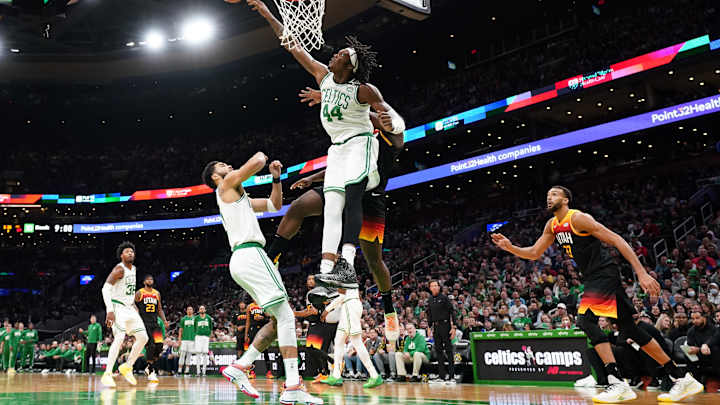1:1 with Orthopedic Surgeon, Dr. Derek Ochiai, on Robert Williams' Knee Procedures, Recovery, and Long-Term Outlook

On Friday, it will be eight weeks since Robert Williams underwent an arthroscopic knee procedure on his left knee, a surgery that came with an eight-to-12-week timeline for his return to the court.
Per A. Sherrod Blakely, who covers the Celtics for CLNS Media and on his Substack, the Timelord will make his season debut "sooner rather than later."
At 12-3, the team with the NBA's best record resides in Boston. The Celtics also lead the league in points per game, but they could use a boost defensively and at limiting opponents to one shot per possession. And to raise banner 18 to the rafters above TD Garden, they'll need Williams healthy and playing up to his potential as a difference-maker at both ends of the court.
As his season debut nears, Bobby Krivitsky spoke with Dr. Derek Ochiai, a board-certified orthopedic surgeon, fellowship trained in sports medicine. In the interview below, Dr. Ochiai sheds light on Williams' knee injury and surgeries and PRP injection he underwent, his recovery, and the long-term outlook for a player pivotal to the Celtics' championship aspirations.
Here's their discussion, edited for length, clarity, and grammar.
Bobby Krivitsky: Are there any long-term concerns that you have stemming from the injury Robert Williams had, a meniscus tear in his left knee, and him undergoing a partial left knee meniscectomy to address it?
Dr. Ochiai: Not really. Those are common type injuries and common surgeries to perform. It's better not to have a meniscal tear, but if you tear your meniscus and trim out the torn part of your meniscus, that's a surgery that hundreds of thousands of people have recovered from fine.
Bobby Krivitsky: How beneficial do you think Williams undergoing a PRP injection will be?
Dr. Ochiai: It's my understanding he had a second surgery after the meniscus.
Bobby Krivitsky: Correct. An arthroscopic knee procedure.
Dr. Ochiai: It sounds like that was to clean out some loose bodies in his knee. Those loose bodies have to come from somewhere. They don't grow on their own. So, it was probably some cartilage fragments. When you tear your meniscus, you sometimes damage some of the cartilage; that can flake off and create these little loose bodies.
Cleaning that out helps with catching and locking your knee, which is probably why he was getting some swelling in his knee. PRP to address the articular cartilage probably won't damage in a lot of people's knees that have meniscal tears. That can really help. There's a lot of evidence showing that PRP can be highly beneficial for articular cartilage damage or injury.
Bobby Krivitsky: After his arthroscopic knee procedure, he was given a timeline of eight to 12 weeks before resuming basketball activities. Two weeks ago, he traveled with the Celtics to New York for a game against the Knicks. And during a media availability, he said he's "stepping it up" in workouts, including dunking and running the floor, and he feels like he can do anything on the court.
Even with the progress he's making, considering the big picture, should the Celtics wait until January for him to make his season debut?
Dr. Ochiai: Basketball is a very high impact sport, and if you don't play NBA basketball, then your knee would probably be better than if you did; for most people.
But I don't see a reason that he should wait. You know, the timeline, those are always guesses. Whenever you see somebody, any athlete who's had surgery for whatever, they'll say it was a successful surgery -- because it's always successful -- and then they'll give a timeframe, but that's really like an educated guess; it's taking into account an average of a lot of people.
And if you look at a bell-shaped curve of averages, you have people on the left side of the bell-shaped curve and on the right side of the bell-shaped curve. So, if the surgery with a meniscectomy, and a clean out of his knee, and a PRP injection, all of those don't necessarily require time to heal. You've got to get the skin to heal from the surgery, but he didn't have a meniscal repair -- I'm assuming he didn't. You don't need the meniscus to heal. The meniscus is as good as it will be, initially after surgery. To clean out loose bodies, you don't need a lot of time to rehab specifically for that.
So yeah, I think that eight-to-12-week timeframe was building in time for him to feel comfortable in his knee; initially, one has pain after surgery, so get that to calm down. With any type of surgery, you'll have atrophy of the leg. The leg will get weaker, no matter how strong it started with; it gets weaker after surgery initially, you have to build that back up. But everybody's different on how quickly that can happen. So, whenever he would feel up to it, if his knee is 90-plus percent as strong as his other knee, and he's not limping, and he has no pain, then that's when he should be able to go back to play.
Bobby Krivitsky: So, and I ask this with Friday representing the eight-week mark for him, when people say to err on the side of caution and wait as long as possible, there's not much reason to do so; is that correct?
Dr. Ochiai: Not for this type of surgery. There are other types of surgery, like an ACL reconstruction or a rotator cuff repair, where you're trying to get tissue to heal. Okay, so then, being conservative and taking into account that healing time of the actual surgery that you did, that's where extending that out a little bit longer would ensure there is a maximum amount of healing before you start.
The surgeries described that he had, the chances of him getting injured again would be, if he met all parameters for a return to play, the injury rate would be exactly the same chance as if he came back a month later or two months later or stayed out the rest of the season and came back next year; it would be the same. There would be an injury rate, because playing in the NBA is a difficult thing most people cannot do, which he is doing, so there's going to be an injury rate, but it'll be the same. So, whenever he feels up to it, he should get back to the sport he loves.
Bobby Krivitsky: And with the goal being for him to be at his best throughout what they hope is a title run, how long would you keep Williams on a minutes restriction once he's back in the lineup?
Dr. Ochiai: That depends on his trainers, his athletic trainers, and his personal trainers and his strength and conditioning coaches, and what he can tolerate. There's a difference in playing 10 minutes and playing 25 minutes. That's the difference between strength and endurance. You can get strength back, but endurance might not come back. And one of the ways you can get endurance back is actually playing; you can start ramping up your minutes. But that's to avoid injury to his knee or anything else because he's not, probably totally in basketball shape until he's playing basketball all the time.
So, usually that's not keeping him out. That's recognizing biology and that if you're not, if you're playing all the time and then stop playing altogether, you really want to ramp up to playing a full game or however many minutes he would typically play.
Bobby Krivitsky: His stamina will factor into this next question, but between shorter bursts with more frequent trips to the bench or longer stretches to keep him loose, is there a preferred method to managing his minutes?
Dr. Ochiai: Not that I'm aware of; I think that's up to the individual. There's pluses and minuses to both of those.
Bobby Krivitsky: When the playoffs arrive, there's a heightened focus and a greater intensity, so the games become more taxing, and there's often one day off and may require travel. So, is there an increased injury risk if the Celtics account for Williams' progress during the regular season but not the changes mentioned?
Dr. Ochiai: You're talking months from now, so he should be as good as he'll get by the time the playoffs start.
Bobby Krivitsky: Williams decided to undergo a partial trim of his meniscus to suit up in the playoffs. And when there were more days between games, he was more impactful, but in the postseason, it was clear he was compromised.
After the arthroscopic knee procedure and the PRP injection he underwent, do you think he'll get back to and sustain performing at the level he was before tearing his meniscus in late March?
Dr. Ochiai: Well, for his sake, I sure hope so. It can certainly happen. On the flip side, his knee is not as good as it was before he tore his meniscus. Nobody would say, 'let's take out some of your meniscus and make it better than it was before if that meniscus is normal.' So, we're not prophylactically taking out people's meniscus to say, 'let's have you be able to play basketball better.'
There's a very good chance that he is at, from a knee level, other things may be better in the future, but from a knee level, there's a good chance he's as good or close to as good as he was before he tore his meniscus. Everybody's different; advances in rehabilitation and strength and conditioning, training and diet; those are advantages that in the 80s and 90s weren't as much of an advantage. So, there's a really good chance he does really well for a long period of time. But having a meniscal tear is an injury to that knee, and you can't be, that knee is not exactly the same as it was before he tore his meniscus.
Further Reading
The Top 5 Plays in Wednesday's Celtics-Hawks Game
Red-Hot Celtics Second Unit has Perfect Mindset
Blake Griffin's Advice to Marcus Smart Helped Lead Celtics to Win Monday
